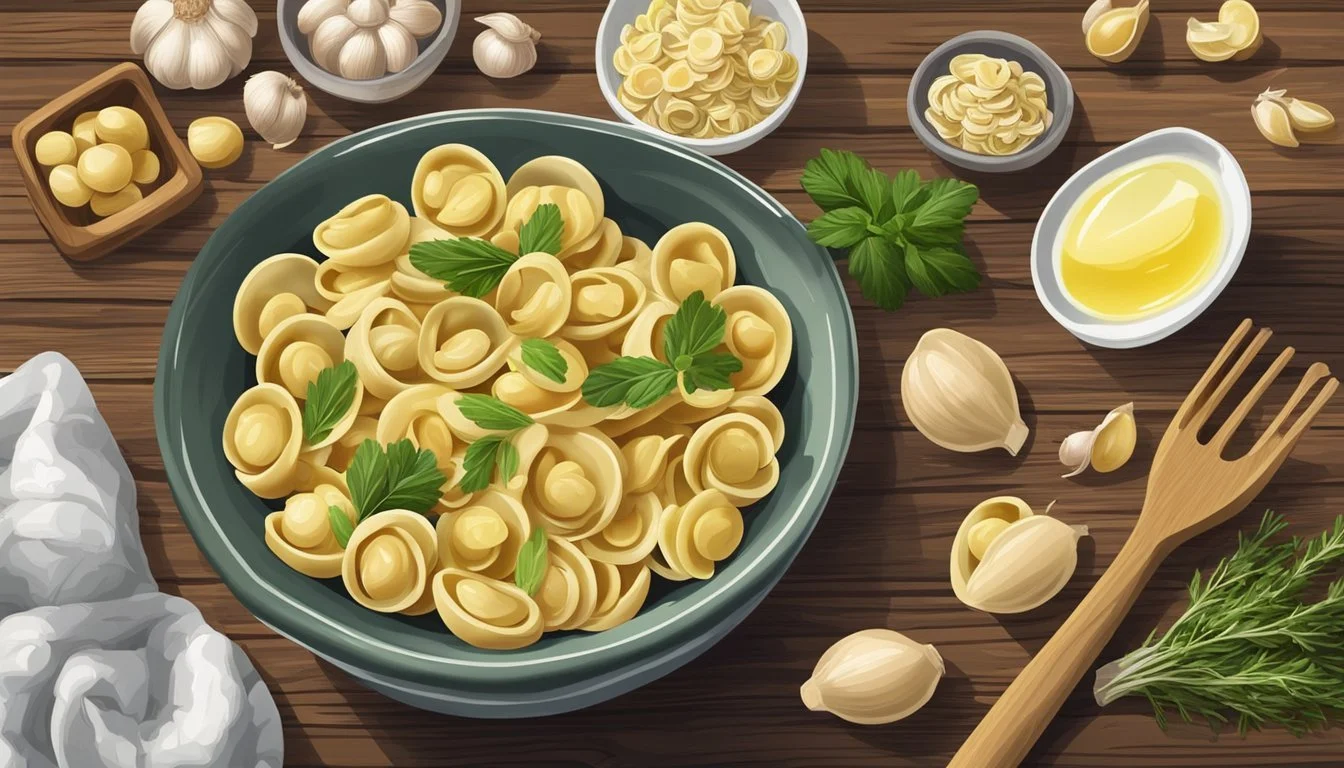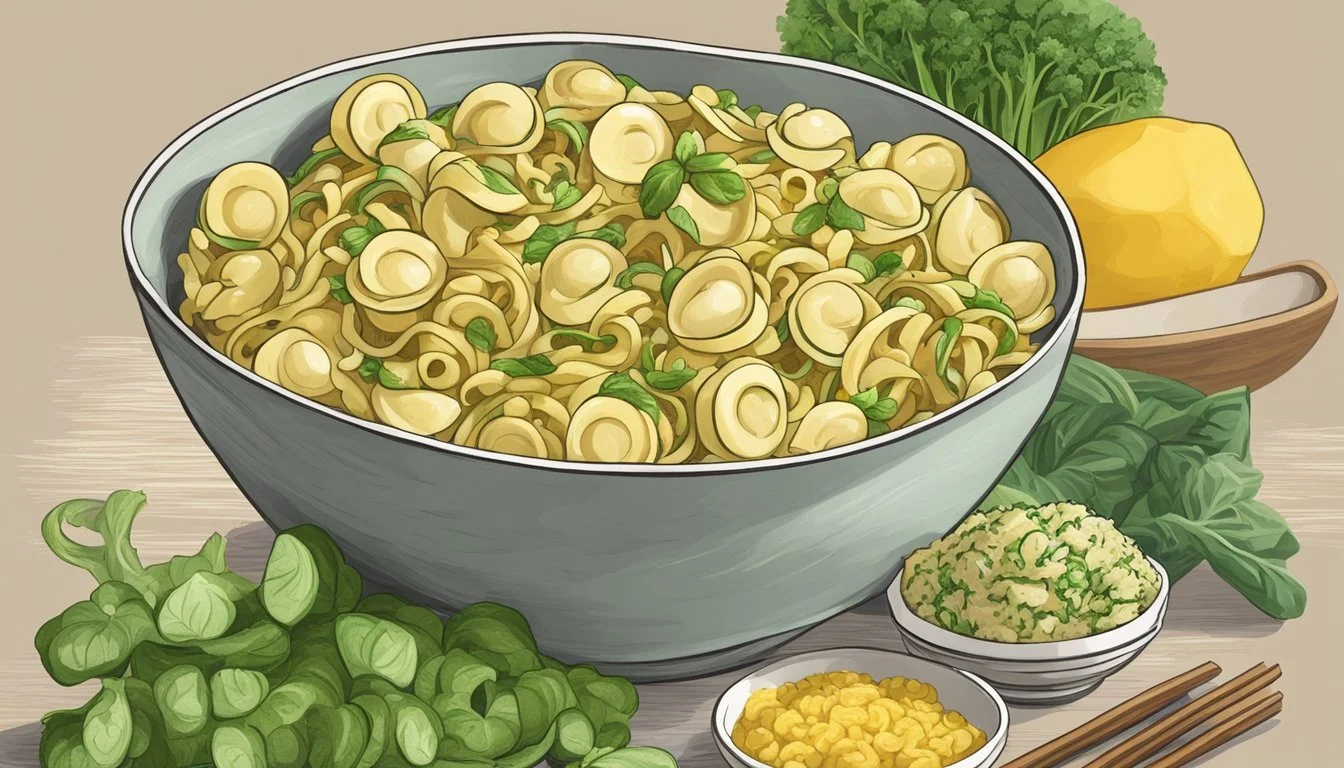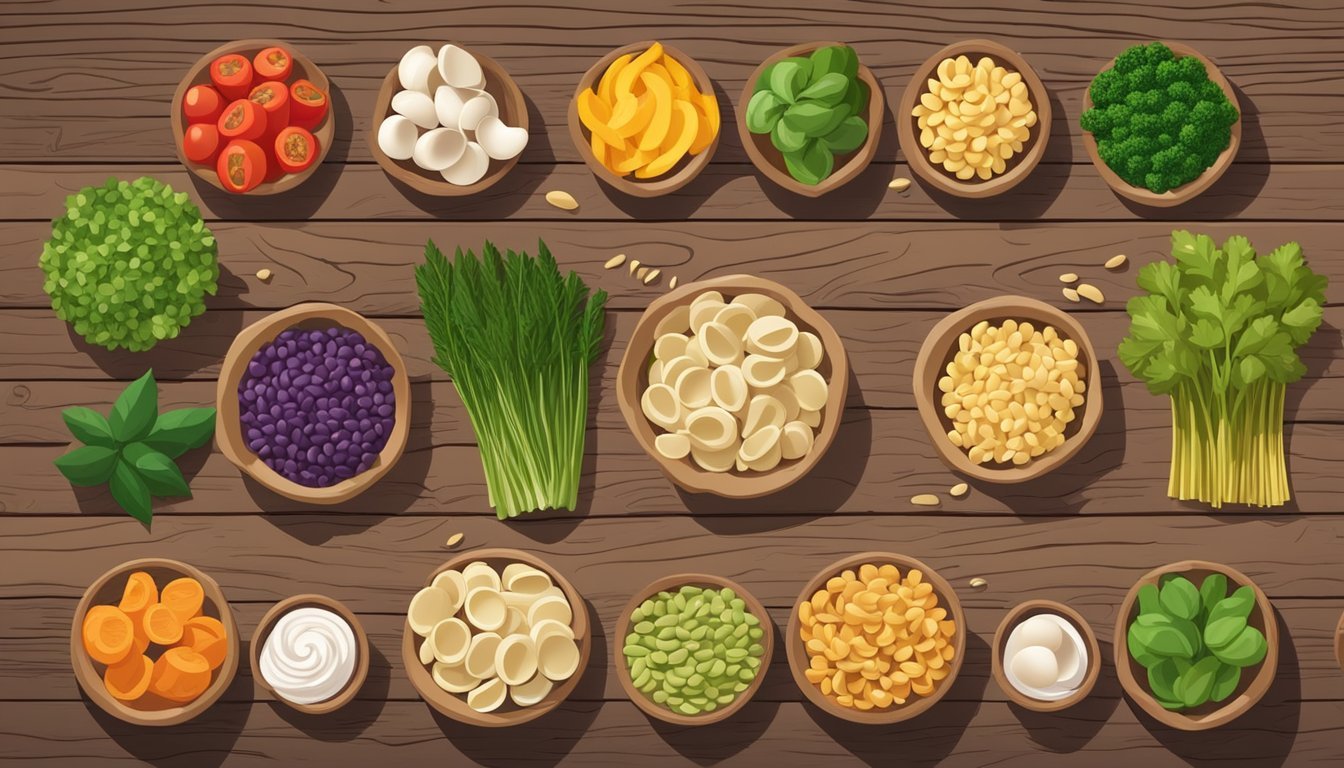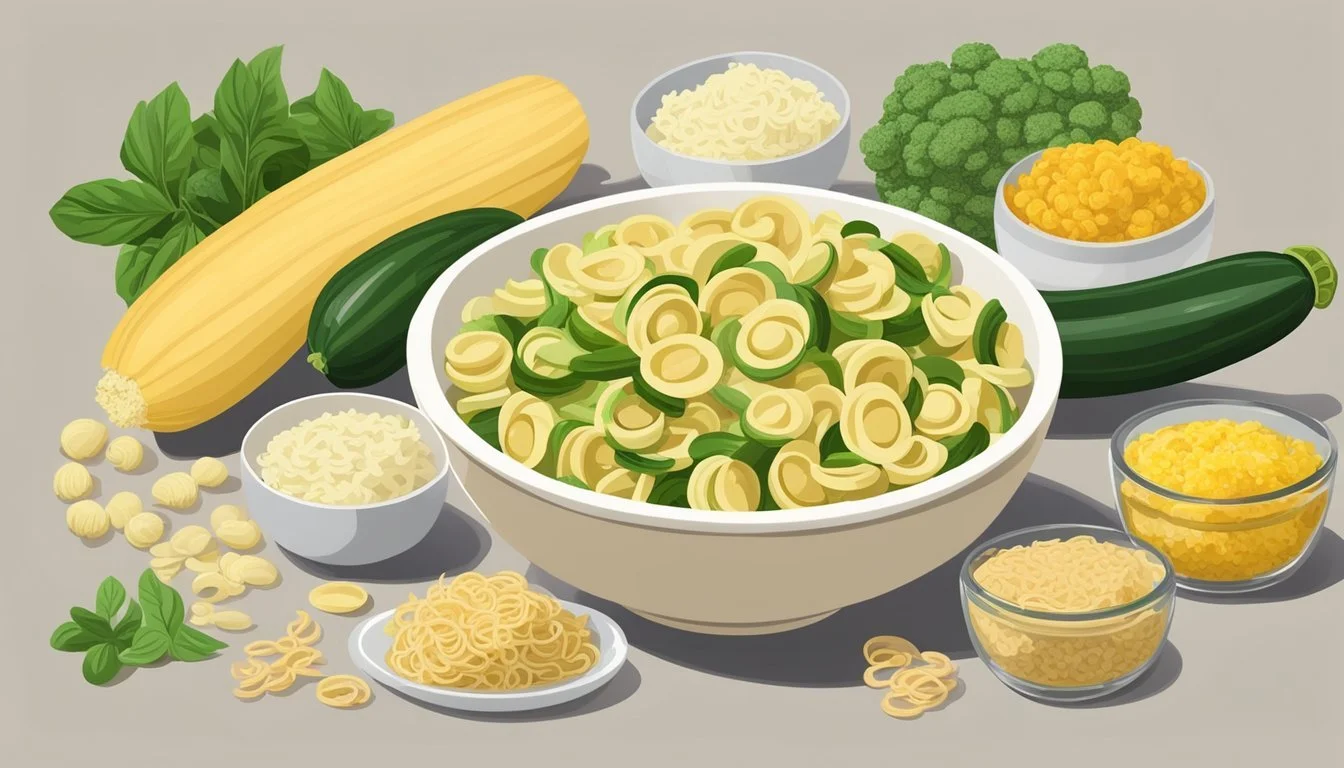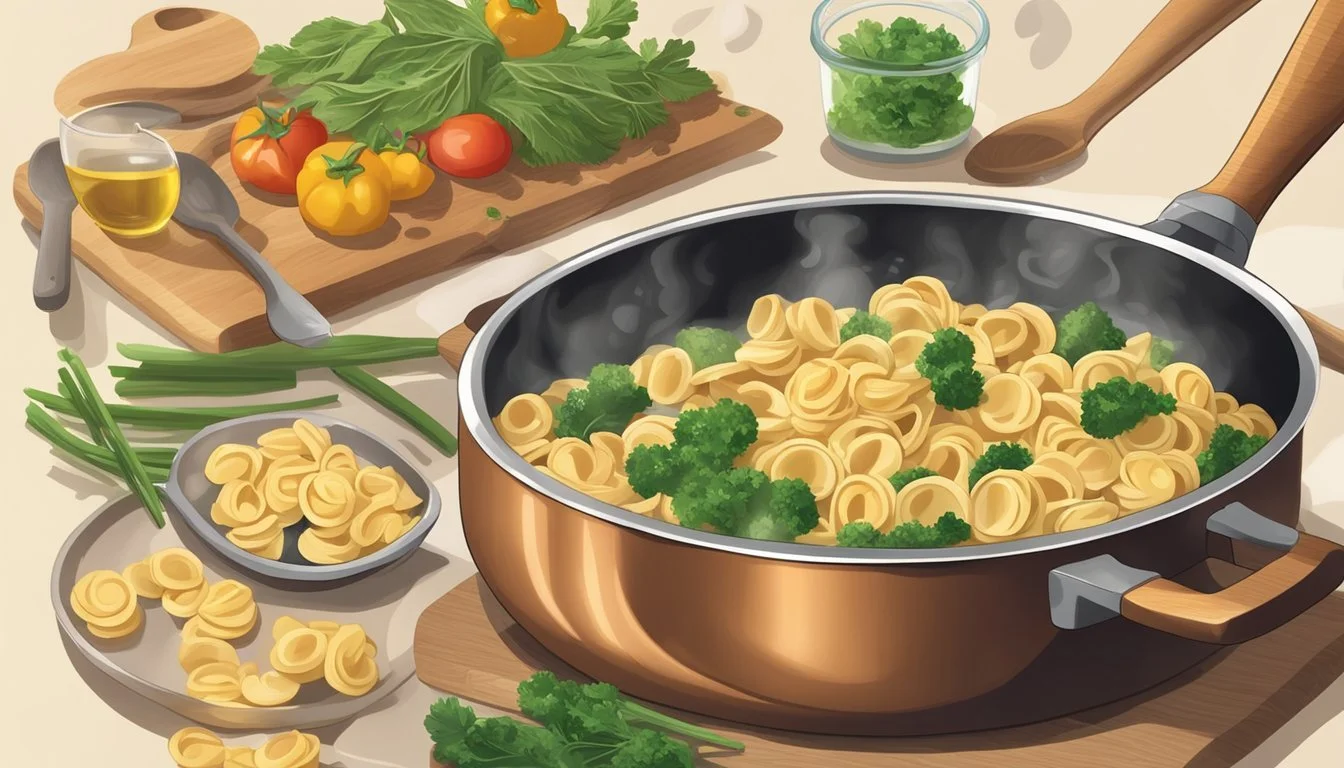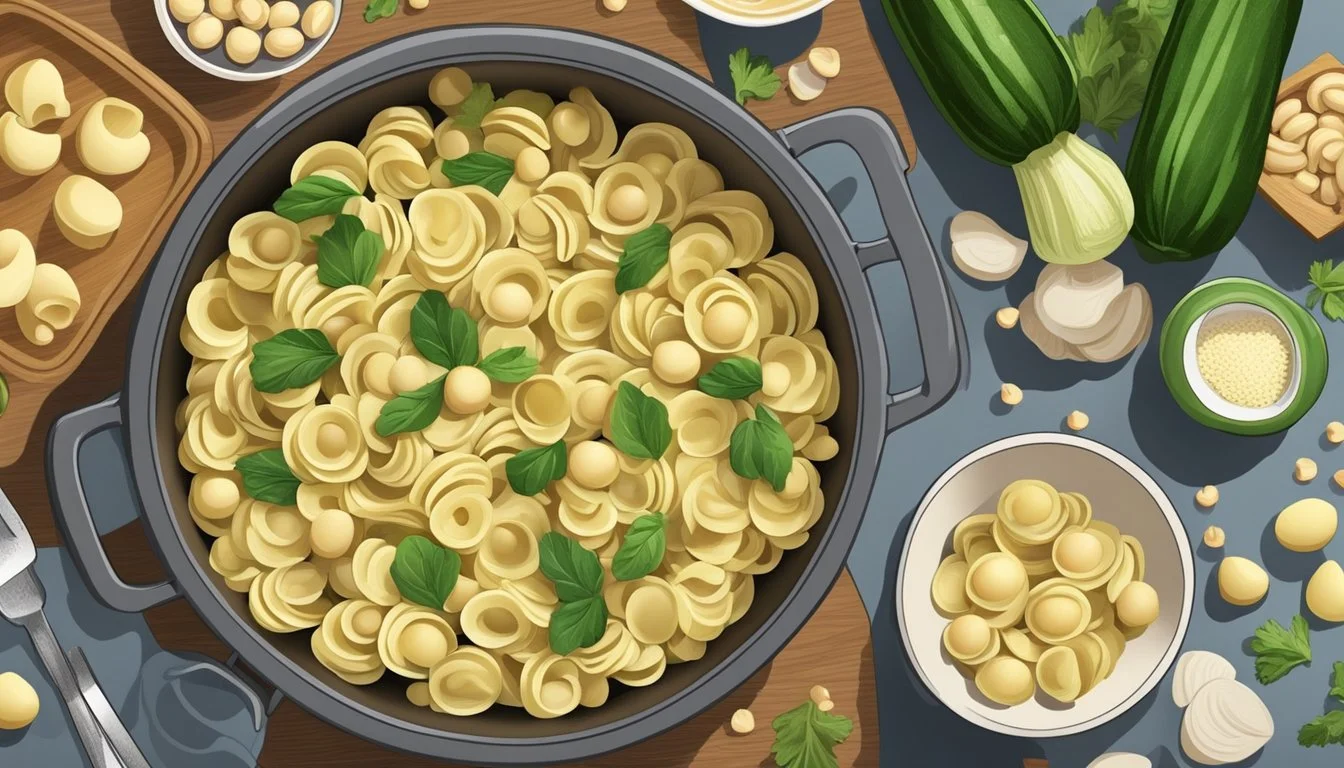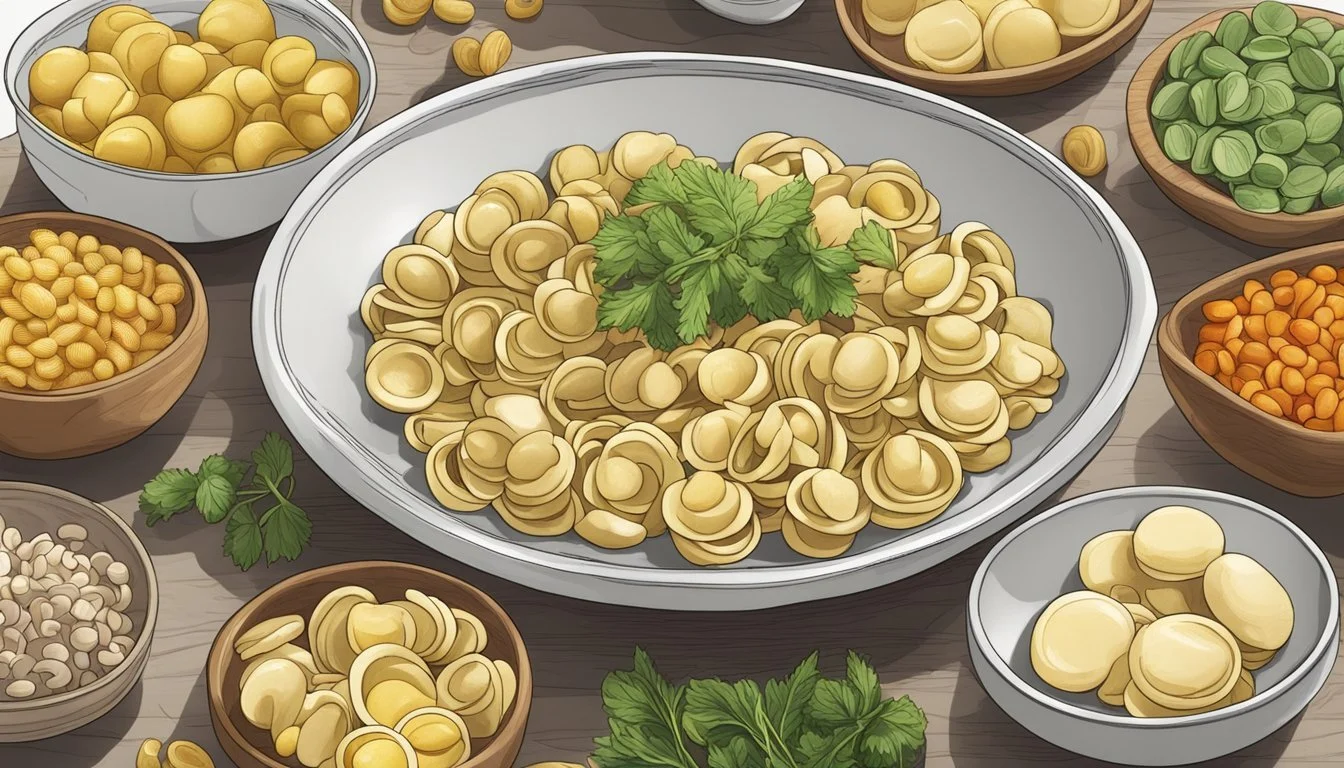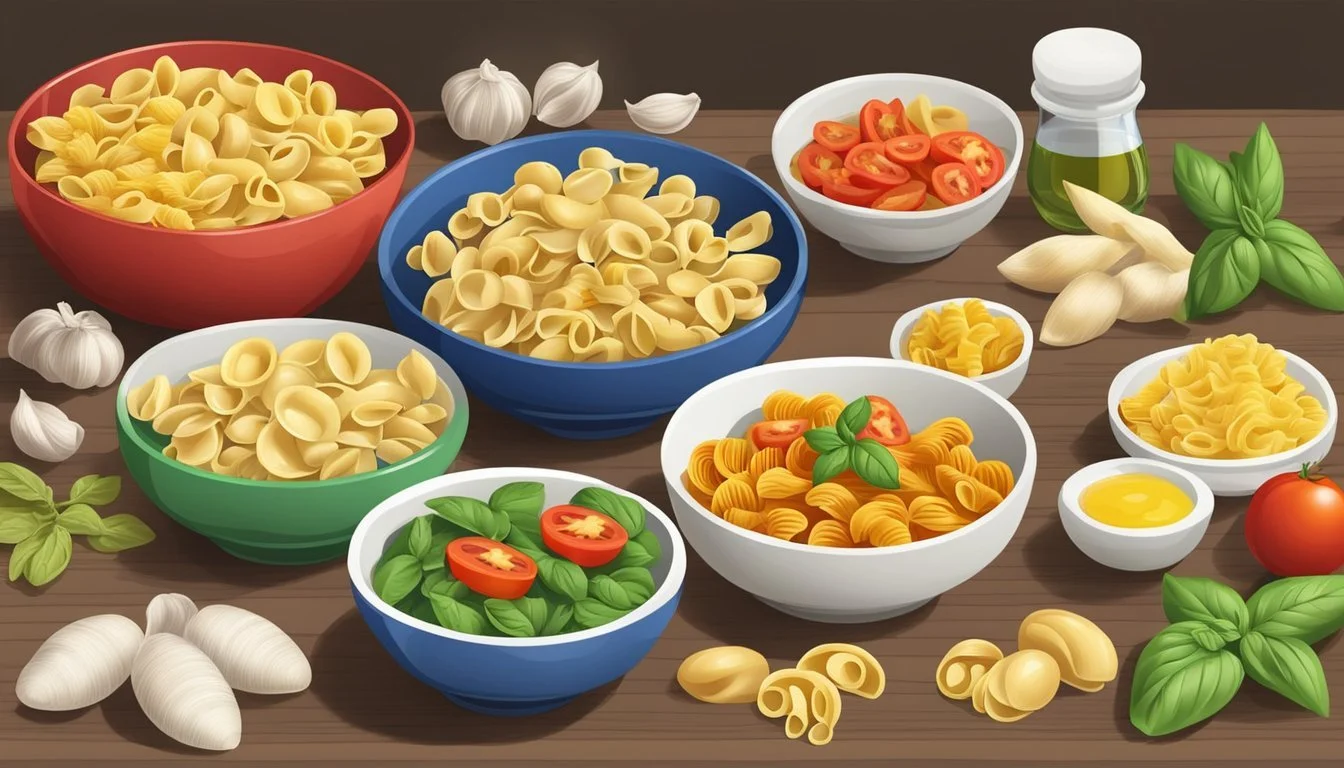Orecchiette Pasta Substitutes
Top Alternatives for Your Italian Dishes
Orecchiette, a type of pasta (What wine goes well with pasta?) hailing from the Puglia region of Southern Italy, is renowned for its unique ear-like shape. The name itself translates to "little ears," which is an apt description of its concave form that superbly traps and holds sauces and small ingredients. Due to its distinctive texture and ability to absorb flavors, orecchiette has become a beloved choice for various robust Italian dishes.
For those unable to access orecchiette or looking for a similar culinary experience, there are several alternatives. Substitutes should ideally maintain the pasta's inherent qualities such as shape and texture that allow for an even distribution of sauce and a satisfying bite. For instance, conchiglie, also known as shell pasta, presents an excellent replacement due to its concave shape which, like orecchiette, serves to capture sauces effectively.
Another versatile substitute is farfalle, which shares its Italian origin and offers a delightful al dente texture suitable for many recipes that typically call for orecchiette. Penne is also a noteworthy substitute, especially in dishes where the pasta's role is to complement a hearty sauce with its firm texture. These substitutes ensure that the essence of the dish remains intact while offering a variation that is accessible and equally delectable.
Understanding Orecchiette
Orecchiette, known for its distinct ear-like shape and firm texture, holds a significant place in Italian cuisine, with strong roots in the southern region of Puglia.
Origins and Culinary Significance
Orecchiette, translating to "little ears" in Italian, hail from the region of Puglia, situated in Southeast Italy. This pasta is a staple of Italian cuisine and embodies the culinary traditions of its origin. In Puglia, it is commonly served with hearty vegetable-based sauces and is particularly famous for being paired with "Cime di Rapa" or broccoli rabe.
Tradition: Orecchiette is traditionally handmade, involving a technique where small discs of dough are indented with a thumb to create their characteristic shape.
Characteristics of Orecchiette Pasta
Orecchiette pasta’s signature concave shape and sturdy texture stem from the use of Durum Wheat. These physical attributes allow it to hold sauces effectively, making it a cherished choice for certain Italian dishes.
Texture: Firm and chewy when cooked, providing a satisfying bite.
Shape: Resembles small ears, hence the name, which assists in scooping up chunky ingredients and sauces.
Choosing the Right Substitute
When selecting an alternative for orecchiette pasta, one must consider factors that affect compatibility and culinary integrity, such as sauce type, pasta shape, and texture.
Factors to Consider
The decision to replace orecchiette should take into account the protein and fiber content of the substitute, which contributes to the pasta's nutritional value. The choice of pasta should have a similar profile to orecchiette in terms of content sourced from durum wheat semolina. Also, considering the versatility of the substitute is key, as it should perform well in a variety of dishes.
Importance of Sauce Compatibility
A suitable substitute must harmonize with the intended sauce. Orecchiette is known for its competence in holding robust and chunky sauces, due to its concave shape. For example, Conchiglie, with its shell-like structure, is particularly adept at capturing and retaining thick sauces.
For tomato-based sauces with pieces of vegetables or meats: Farfalle, Fusilli
For creamier or cheese-based sauces: Penne Pasta, Corallini
Shape and Texture Considerations
The texture of the pasta affects the dish's mouthfeel and the shape's ability to catch and retain sauce. Fusilli, with its spirals, and Farfalle, known as bowtie pasta, offer firm textures that are versatile in handling a multitude of sauces. Both are excellent at trapping sauces within their contours, although they present it in a visually distinct way from orecchiette's round, cupped shape.
Fusilli: Spiraled, catches sauce within its twists.
Farfalle: Flat, pinched in the middle, allows for a varied texture.
The chosen pasta should lend a similar bite and overall feel as orecchiette, ensuring the integrity of the traditional dish is maintained while adapting it to available ingredients.
Types of Pasta Substitutes
When seeking alternatives for orecchiette pasta, the form and surface of the substitute are vital considerations. Pasta comes in numerous shapes and textures, each interacting with sauces and ingredients in distinctive ways. The following subsections cover short and long pasta substitutes, as well as more unique options, each matching various requirements of your recipes.
Short Pasta Varieties
Farfalle: Often referred to as bow-tie pasta, farfalle is recognized for its butterfly shape. It's not only appealing visually but also functional; its pinched middle ensures it cooks evenly and captures sauces effectively.
Fusilli: This pasta type is characterized by its spirals and corkscrew shape, allowing it to grip onto sauces firmly, much like orecchiette.
Conchiglie: Resembling seashells, conchiglie pasta holds chunky sauces within its hollow structure, similar to the way orecchiette does.
Penne: Including variants like penne rigate, with its ridged surface, and penne lisce, with a smoother finish, penne's cylindrical shape makes it a versatile substitute for orecchiette.
Table of Short Pasta Substitutes:
Substitutes Shape Description Texture Suitable Sauces Farfalle Bow-tie, pinched middle Firm Light to medium Fusilli Corkscrew, spirals Versatile Robust, cream-based Conchiglie Shell-like cavities Holds sauces Chunky, meaty Penne Cylindrical, ridged Versatile Various, including Bolognese
Long Pasta Varieties
Penne: As mentioned above, penne can also be considered in long pasta varieties due to its length and capacity as a substitute, especially the larger variations such as pennoni or mostaccioli, which are well-suited to hearty meat sauces.
Novel Pasta Substitutes
Gnocchi: While not a pasta in the traditional sense, these small dough dumplings can replace orecchiette in dishes requiring a soft and chewy bite.
Cavatelli: Resembles tiny hot dog buns and offers a dense texture. Despite being less common, they can mimic the sauce-capturing ability of orecchiette.
Gluten-Free and Alternative Grain Options
When seeking substitutes for traditional orecchiette pasta, those adhering to gluten-free diets or preferring alternative grains have a variety of options. Here, both whole wheat choices and entirely gluten-free substitutes offer a diverse range of textures and flavors that cater to different dietary requirements.
Whole Wheat and Alternative Flours
Whole Wheat Pasta: An option for those who do not require a gluten-free diet but want a healthier alternative. Whole wheat pasta contains more fiber and nutrients compared to those made with semolina flour.
Gluten-Free Flours: Innovative pastas are now made from rice flour, corn flour, and even legume-based flours. Gluten-free substitutes such as these aim to mimic the bite and satisfaction of traditional pasta.
Rice and Other Grains
Rice: A staple substitute for pasta, especially in gluten-free diets. Options include brown rice pasta and wild rice, which both offer a chewy texture and are rich in nutrients.
Alternative Grains: Quinoa and millet are nutrient-dense grains that are inherently gluten-free. When cooked, they provide a pleasant texture that can stand in for the bite of orzo or orecchiette in salads and soups.
Non-Pasta Substitutes
When seeking alternatives to orecchiette pasta, one may consider non-pasta options that cater to dietary preferences or simply offer a twist in texture and flavor. These substitutes often provide additional nutritional benefits, such as increased vegetable intake or higher protein content.
Vegetable Alternatives
Vegetables can mimic the shape and mouthfeel of orecchiette and are suitable for those pursuing a low-carb diet or a boost in their vegetable consumption. Spoon-shaped vegetables like squash can be cut and hollowed out to create a concave shape similar to orecchiette. Zucchini can also be sliced and then stamped out into small rounds.
Squash: Roast or steam small pieces to tenderize and then use them as a base for sauces.
Zucchini: Slice, stamp into rounds, and sauté lightly for a firm, pasta-like substitute.
Experimenting with spinach extract or tomato extract can add a pop of color and a nutritional boost to these vegetable pasta alternatives.
Legume-Based Options
Legumes offer homemade, protein-rich pasta substitutes. They can take on a variety of shapes and are excellent for those on a vegan diet.
Lentil discs: Shape cooked lentils into small patties and lightly pan-fry for a dense, satisfying bite.
Chickpea flour: Use to make miniature dumplings, reminiscent of orecchiette, that are rich in protein and gluten-free.
These legume-based alternatives are convenient for those looking for homemade options that are both nutrient-dense and versatile in pairing with traditional pasta sauces.
Preparing and Cooking Substitutes
Choosing an appropriate substitute for orecchiette pasta involves understanding how these alternatives behave during the cooking process. The cook time, boiling techniques, and final dish consistency are pivotal factors that ensure the success of using substitute pastas like fusilli, farfalle, or penne.
Cook Time Variables
Different pasta varieties require varying cook times to achieve the perfect al dente texture. Fusilli typically requires 12-15 minutes to cook properly, but it's essential to check the packaging as brands may vary. Farfalle, with its thinner and thicker parts due to its bow-tie shape, can offer different textures, often cooking tenderly in the center while retaining a chewy edge. Penne pasta generally cooks within 10-13 minutes. Monitoring each pasta's texture during boiling is key to prevent overcooking.
Boiling Techniques
For any pasta type, it's advisable to use a large pot of salted water for boiling, allowing ample room for the pasta to move and cook evenly. The water should be brought to a rolling boil before adding the pasta. Stirring occasionally will prevent sticking and ensure even heat distribution. Pasta salads benefit from pasta that's cooked al dente and then rinsed under cold water to stop the cooking process and cool the pasta down quickly.
Finalizing Dish Consistency
Achieving the desired consistency in the final dish involves the right sauce pairing. Robust and chunky sauces clamp onto the spiral grooves of fusilli and the folds of farfalle efficiently, much like they would with orecchiette. Salads, particularly pasta salads, call for pasta that's firm to the bite; after boiling, one can toss them in a light vinaigrette or creamy dressing to harmonize with the other salad ingredients. Cooking the substitutes to al dente ensures they maintain their structure when mixed with sauces or salad dressings.
Integrating Substitutes in Recipes
When incorporating substitutes for orecchiette in recipes, one must consider the texture and shape of the pasta in relation to the sauce and other ingredients. Adapting the pasta to the dish’s requirements ensures that the essence of the recipe is maintained.
Pasta Salads and Cold Dishes
In pasta salads and cold dishes, salad-friendly substitutes like farfalle and fusilli are ideal. These shapes are not only visually appealing in salads, but their structure also holds dressing well, ensuring a uniform distribution of flavour in every bite. For example:
Farfalle - Pair with a pesto sauce or light vinaigrette to complement its firm texture.
Fusilli - Excellent in a pasta salad that features chunks of vegetables or cheese, as the corkscrews catch bits of the ingredients.
Hearty Sauces and Stews
When pairing pasta with hearty sauces and stews, the substitute should similarly anchor the weighty ingredients. Pasta such as conchiglie and penne works well:
Conchiglie - Their shell-like shape makes them perfect for scooping up chunky sauce or meat sauces.
Penne - Its cylindrical form is adept at trapping hearty sauces and is particularly well-suited for tomato sauce or cream sauce-based dishes.
Choosing a substitute pasta with a complementary shape and firmness will translate to a cohesive dish that honors the integrity of the original recipe.
Pairing Substitutes with Proteins and Vegetables
When selecting pasta substitutes, it's crucial to consider how well they will pair with different proteins and vegetables to maintain the integrity of traditional orecchiette dishes.
Meat and Seafood Combinations
Substitute: Farfalle
Meat Pairing: Farfalle works exceptionally well with Italian sausage, as its bow-tie shape can catch pieces of the sausage, ensuring a flavorful bite.
Seafood Pairing: This pasta shape is sturdy enough to hold up to the weight of seafood such as shrimp, making it a great base for seafood pasta dishes.
Substitute: Fusilli
Meat Pairing: Pork chunks or meatballs are an ideal match for fusilli's corkscrew shape, creating a hearty meal with each spiral coated in sauce and meat.
Seafood Pairing: The grooves of fusilli allow it to trap light seafood sauces, perfectly complementing delicate proteins like scallops.
Vegetarian and Vegan Options
Substitute: Penne
Vegetable Pairing: Penne's tube-like structure is excellent for pairing with asparagus or broccoli, allowing the vegetables to tuck into the pasta and provide a satisfying texture contrast.
Protein Pairing: It is also suitable for vegan meat alternatives, which can be sliced or crumbled to distribute evenly among the penne.
Substitute: Tubettini
Vegetable Pairing: Smaller and more delicate veggies like peas nestle well into the small tubes of tubettini, distributing the vegetable's sweetness evenly throughout the dish.
Protein Pairing: Tofu can be a good protein to combine with tubettini, as it absorbs the surrounding flavors and adds a pleasant bite to the meal.
Enhancing Flavors with Substitutes
When substituting Orecchiette pasta, it's crucial to consider how alternative pasta shapes interact with sauces and accompaniments. The key to enhancing flavors lies in the ingredients that complement the substitute pasta.
Herbs and Spices
One can enhance the flavors of pasta dishes by selecting appropriate herbs and spices. For example, one might use basil and oregano in a pasta salad with farfalle, or add a pinch of red pepper flakes to fusilli to amplify its affinity for hearty sauces. Opting for robust spices can invigorate a dish, especially when Orecchiette is swapped for a pasta with a less distinctive texture.
Pasta Substitute Suggested Herbs and Spices Farfalle Basil, Oregano, Black Pepper Fusilli Red Pepper Flakes, Garlic Powder Penne Thyme, Rosemary
Cheeses and Butters
The addition of cheeses and butters can greatly influence the final flavor of a pasta dish. For example, using Parmesan with conchiglie enhances its ability to marry well with chunky sauces, similar to Orecchiette. When experimenting with pasta like penne, one might incorporate a rich butter sauce or olive oil to complement its cylindrical shape.
In preparations requiring a more pronounced flavor, such as when pairing with Cime di Rapa or Broccoli Rabe, the choice of cheese or butter can make a significant difference.
Pasta Substitute Cheese or Butter Pairings Conchiglie Shaved Parmesan, Ricotta Penne Melted Butter, Olive Oil
Incorporating these ingredients thoughtfully can enhance the dish's overall taste and depth, bringing it closer to the original experience intended with Orecchiette pasta.
Conclusion
Exploring alternatives to Orecchiette pasta encourages both creativity and flexibility in cooking. The distinctive shape of Orecchiette, resembling small ears, allows it to hold sauces well. However, various Italian pasta types serve as competent stand-ins, providing similar functionality and enriching the dining experience with a diversity of textures and tastes.
Top Orecchiette Pasta Substitutes:
Penne: Known for its cylinder shape, penne readily absorbs sauces.
Farfalle: With its butterfly shape, farfalle offers a unique twist to dishes typically made with Orecchiette.
Tubettini: It provides a firmer texture, along with a shape that echoes Orecchiette.
Conchiglie: Shell-like in form, this pasta holds chunky sauces effectively.
These substitutes are versatile, ensuring that the essence of the dish remains, despite the absence of Orecchiette. Cooking enthusiasts can experiment with these varieties, noting their ability to interact with different sauces and ingredients.
Choosing an adequate Orecchiette substitute is less about finding an identical match and more about understanding the properties that make this pasta unique. Then, one can select an alternative that mirrors these characteristics. This approach ensures the integrity of the original dish while allowing the enjoyment of the vast selection that Italian pasta offers.


